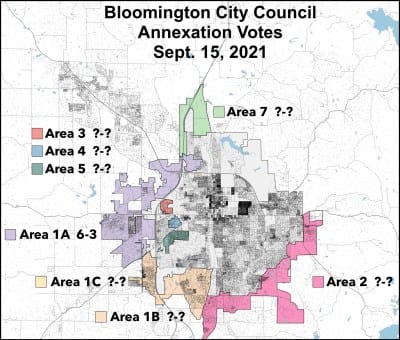1 down, 7 to go: Bloomington city council OKs westside area for annexation, recesses meeting until Sept. 22 for remaining votes

Just one of eight proposed areas for annexation was put to a vote by Bloomington’s nine-member city council on Wednesday night.
 Councilmembers voted 6–3 to make Area 1A on Bloomington’s west side a part of Bloomington. Dissenting were Dave Rollo, Susan Sandberg, and Ron Smith.
Councilmembers voted 6–3 to make Area 1A on Bloomington’s west side a part of Bloomington. Dissenting were Dave Rollo, Susan Sandberg, and Ron Smith.
Before taking votes on the seven other proposed annexation areas, the council recessed its meeting until next Wednesday, Sept. 22 at 6:30 p.m.
The 6–3 split on Area 1A was the same breakdown for Wednesday’s council votes on all but one of the fiscal plans associated with the annexation ordinances.
Also on Wednesday, the same 6–3 split divided the council on a proposal to subtract some territory from proposed annexation Area 2, which lies to the southeast of the city. Rollo and Smith moved an amendment that would have deleted from Area 2 a chunk that looked identical to one Smith had previously proposed to delete at a special Aug. 31 council meeting.
The ordinance adding Area 2 did not get a vote from the council on Wednesday. It will have to wait until next week, along with the other remaining ordinances.
Based on the deliberations so far, it looks likely that next week the ordinances that add six more areas, including Area 2, will get majority support by at least the same 6–3 margin.
The seventh piece of territory, which is Area 7 on the north side, is expected to be voted down unanimously, because Bloomington mayor John Hamilton’s administration no longer thinks it needs to be brought into the city of Bloomington.
The unanimous vote to recess the meeting came at 11:21 p.m., which was just short of five hours after the meeting started.
Part of the backdrop to Wednesday’s meeting was a news release from County Residents Against Annexation (CRAA), a group opposed to adding the proposed territory to the city.
According to the CRAA news release, more than 5,000 people in the county have signed pre-remonstrance petitions. The estimated population in the proposed annexation areas is around 14,000. What counts for remonstration purposes are the signatures of property owners in annexation areas.
The remonstrance process cannot actually start until the city council approves the ordinances. Under Indiana’s annexation law, the remonstrance procedures will be handled by the county auditor’s office.
After the council approves an annexation ordinance, the next step for property owners who oppose annexation would be to sign a remonstrance paperwork, which will be made available by the auditor’s office.
The pre-remonstrance petition signatures won’t count for the official remonstrance process. Remonstrance is an area-by-area affair.
The CRAA news release from Sept. 15 indicates not enough pre-remonstrance signatures have been collected for Area 1A, Area 1B, Area 1C and Area 3, to meet legal thresholds, if those were the official signatures. For those areas, the CRAA news release indicates optimism that eventually enough property owners would sign a remonstrance petition to meet one of the legal thresholds.
Other areas have achieved some legal threshold, if the pre-remonstrance signatures all translate into official remonstrance signatures, according to CRAA.
According to CRAA, Area 2 (Southeast Area) has pre-remonstrance signatures from 60 percent of property owners, which all other things being equal, would meet the 50-percent threshold for getting the question in front of a judge.
The CRAA news release also says that Areas 4 and Area 5, two of the so-called islands, have pre-remonstrance signatures from more than 65 percent of the property owners. That would be enough to stop the annexation, if all of those pre-remonstrance signatures translate into valid remonstrance signatures.
One reason that a pre-remonstrance petition signature might not count as valid is if there is a remonstrance waiver attached to the property.
The city of Bloomington takes the view that waivers signed before a 2019 law was enacted, which invalidated many older waivers, are still valid, because its annexation process started in 2017.
The determination of the valid signature count could depend on the validity of remonstrance waivers. And whether remonstrance waivers are valid is likely to end up in court.




Comments ()